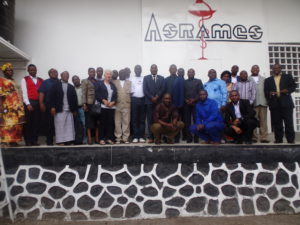QUAMED est une association à but non lucratif qui a pour objectif de contribuer à l’amélioration de l’accès à des médicaments de qualité.
Notre volonté est de susciter la prise de conscience des acteurs impliqués, et de leur donner les moyens de renforcer leurs systèmes d’assurance qualité. Nous souhaitons associer des acteurs du monde entier impliqués dans l’accès à des médicaments de qualité et nous croyons que c’est en mutualisant les ressources disponibles que nous serons le plus performant et aurons le meilleur impact. QUAMED repose donc sur un partage de l’information et des ressources et nous sommes convaincus que c’est en utilisant ces synergies que nous pourrons créer les conditions nécessaires pour avoir une influence directe sur le marché d’une part, et pour avoir la puissance de plaidoyer permettant un impact politique d’autre part.
Dans ce but, nous nous sommes dotés d’une structure adaptée et avons développé et continuons à développer une série d’activités qui vous sont proposées afin de vous aider à renforcer votre assurance qualité et d’améliorer vos pratiques en terme d’approvisionnement en produits pharmaceutiques.
Ce sont ces facteurs qui nous permettront d’atteindre l’objectif ultime de QUAMED, à savoir permettre l’accès à des médicaments de meilleure qualité pour le plus grand nombre.
Voici un résumé de tout ce que vous devez savoir sur la structure, les activités, le fonctionnement et le financement
QUAMED: flyer with information on the new QUAMED
QUAMED became at the beginning of 2017 an independent not-for-profit entity. At the meeting of the Be-cause Health Medicines WG of 31/01/2017, Jean-Michel Caudron and Cécile Cortina have presented the main features of the new QUAMED ASBL.
The new QUAMED leaflet (attached, both in English and French), which details the mandate, activities and functioning of the new QUAMED. This is of interest both for individuals and organizations, either for accessing QUAMED services or for becoming associative members.
British Medical Journal: Quality assurance of medicines supplied to low-income and middle-income countries: poor products in shiny boxes?
Source: QUAMED
Quality assurance of medicines supplied to low-income and middle-income countries: poor products in shiny boxes?
Dear BeCause Health friends, dear friends of the new QUAMED,
I am very happy to share this open-access publication (also available at http://gh.bmj.com/content/2/2/e000172), which resulted from the first analysis of data derived from QUAMED operational activities. The analysis was carried out in the framework of Ariadna Nebot’s master thesis at ITM.
We evaluated the compliance of a sample of pharmaceutical distributors active in sub-Saharan Africa (either based in Europe or in sub-Saharan Africa) with the standards of the WHO guideline ‘Model Quality Assurance System (WHO MQAS) for procurement agencies’. This part of the study (the “quantitative” one) consisted of a retrospective secondary analysis of data collected by QUAMED auditors. In a second part of the study (the “qualitative survey”) we investigated factors favoring or hindering the adequate implementation of the MQAS; this was done by means of formal and informal interviews with key informants.
Overall, our findings suggests that international distributors based in Europe perform, on average, better than those based in sub-Saharan Africa. However, some weaknesses are ubiquitous and concern the most critical processes, such as the initial selection of the products and the ongoing reassessment of their quality. According to our “qualitative” findings, this is due to several different factors: weak regulatory oversight, insufficient human/financial resources, weak negotiating power, limited judicial autonomy and/or lack of institutional commitment to quality. Even if based on a small, convenient sample of distributors, these findings suggest that pharmaceutical distributors active in sub-Saharan Africa generally do not apply stringent criteria for selecting products and suppliers. Therefore, product quality is not consistently assured but depends on the requirements of purchasers.
While long-term solutions are awaited, we strongly suggest that collaboration and transparent exchange of information between regulators from the North and the South should be pursued; and that the WHO MQAS guideline should be used by all concerned stakeholders as an evaluation and training tool to upgrade the current standards of practice of pharmaceutical distributors active in sub-Saharan Africa.
Une article intéressant sur la qualité des médicaments dans le British Medical Journal
Source: QUAMED
Quality assurance of medicines supplied to low-income and middle-income countries: poor products in shiny boxes?
Dear BeCause Health friends, dear friends of the new QUAMED,
I am very happy to share this open-access publication (also available at http://gh.bmj.com/content/2/2/e000172), which resulted from the first analysis of data derived from QUAMED operational activities. The analysis was carried out in the framework of Ariadna Nebot’s master thesis at ITM.
We evaluated the compliance of a sample of pharmaceutical distributors active in sub-Saharan Africa (either based in Europe or in sub-Saharan Africa) with the standards of the WHO guideline ‘Model Quality Assurance System (WHO MQAS) for procurement agencies’. This part of the study (the “quantitative” one) consisted of a retrospective secondary analysis of data collected by QUAMED auditors. In a second part of the study (the “qualitative survey”) we investigated factors favoring or hindering the adequate implementation of the MQAS; this was done by means of formal and informal interviews with key informants.
Overall, our findings suggests that international distributors based in Europe perform, on average, better than those based in sub-Saharan Africa. However, some weaknesses are ubiquitous and concern the most critical processes, such as the initial selection of the products and the ongoing reassessment of their quality. According to our “qualitative” findings, this is due to several different factors: weak regulatory oversight, insufficient human/financial resources, weak negotiating power, limited judicial autonomy and/or lack of institutional commitment to quality. Even if based on a small, convenient sample of distributors, these findings suggest that pharmaceutical distributors active in sub-Saharan Africa generally do not apply stringent criteria for selecting products and suppliers. Therefore, product quality is not consistently assured but depends on the requirements of purchasers.
While long-term solutions are awaited, we strongly suggest that collaboration and transparent exchange of information between regulators from the North and the South should be pursued; and that the WHO MQAS guideline should be used by all concerned stakeholders as an evaluation and training tool to upgrade the current standards of practice of pharmaceutical distributors active in sub-Saharan Africa.

